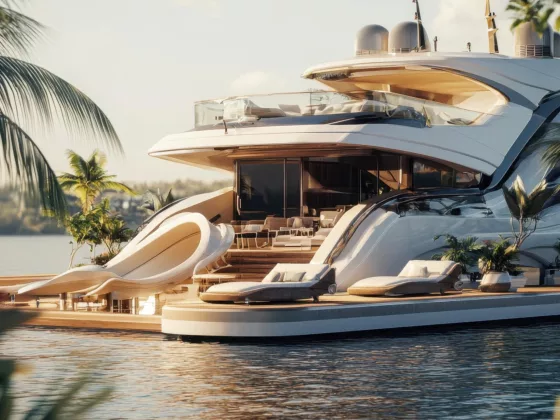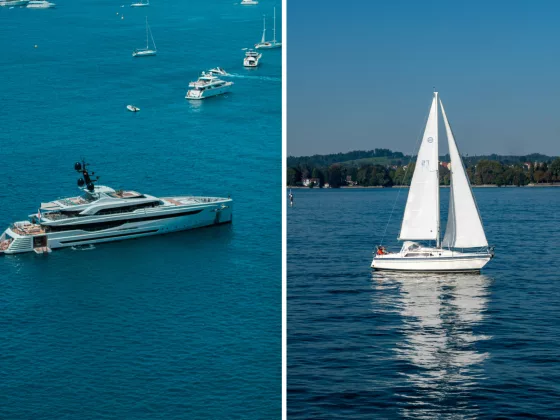Why Are Yachts Limited to 12 Guests? The Maritime Law Behind Luxury Cruising
Ever wondered why even the world's most magnificent superyachts—floating palaces stretching well over 300 feet with multiple decks, helipads, and swimming pools—almost invariably limit their guest capacity to exactly 12 people? It's a curious constant in luxury yachting that has nothing to do with superstition and everything to do with complex international maritime regulations.
In this blog, we'll answer why are yachts limited to 12 guests by exploring the international laws, safety requirements, and economic factors behind this seemingly arbitrary number. This passenger threshold has fundamentally shaped yacht design, pricing, and the very nature of luxury yachting experiences. Let's navigate the fascinating reasons behind this universal limitation that has inadvertently defined one of the most exclusive travel experiences available today.
1. SOLAS Regulations: The Foundation of Maritime Safety

The 12-passenger limit stems primarily from the International Convention for the Safety of Life at Sea (SOLAS). This pivotal maritime treaty draws a clear distinction in vessel classification based on passenger count.
According to SOLAS:
- Any vessel carrying 12 or fewer passengers is classified as a "pleasure vessel"
- Any vessel carrying more than 12 passengers is classified as a "passenger ship"
- This distinction applies regardless of the vessel's size or luxury level
This classification threshold might seem arbitrary, but it creates a profound regulatory boundary with far-reaching implications. Once classified as a passenger ship, a vessel must comply with substantially more stringent safety regulations, dramatically increasing construction, operational, and certification costs.
The SOLAS regulations were originally developed following the Titanic disaster and have evolved over decades to ensure safety at sea. For yacht owners and operators, however, they create a clear incentive to remain within the 12-guest limit.
But SOLAS is just the beginning. Another critical reason why yachts are limited to 12 guests relates to the extensive safety modifications required once this threshold is crossed: a cascade of additional safety requirements comes into play.
2. Enhanced Safety Requirements Beyond the Threshold

Superyachts are typically designed for private use, and the 12-guest limit allows them to operate under private yacht classifications rather than commercial passenger vessel rules. This distinction is critical when considering the safety requirements imposed on vessels exceeding this threshold.
Ships carrying more than 12 guests must implement numerous additional safety features, including:
- Expanded lifeboat capacity and more frequent mandatory safety drills
- Advanced fire suppression systems meeting higher commercial standards
- Structural reinforcements to satisfy commercial safety laws
- Additional watertight compartments and bulkheads
- Enhanced emergency power systems and redundancies
These requirements not only increase costs but often require design compromises that reduce the luxurious feel of the vessel. For example, passenger ships must incorporate additional fire zones with specialized doors and barriers that can disrupt the open, flowing layouts that define luxury yacht design. They must also maintain more complex evacuation routes and expanded life-saving equipment storage areas that claim valuable space otherwise devoted to guest amenities.
While these physical modifications are substantial, the bureaucratic and administrative burden provides yet another explanation for why yachts are limited to 12 guests. The certification process for vessels exceeding this capacity creates substantial operational challenges.
3. The Certification and Compliance Burden

Perhaps the most significant deterrent to exceeding the 12-guest threshold is the extensive certification process. To carry more than 12 guests, a yacht must be certified as a passenger ship—a process involving:
- Extensive documentation and regulatory paperwork
- Initial comprehensive inspections by maritime authorities
- Certification of compliance with passenger vessel standards
- Regular verification of continued compliance
- Substantial application and processing fees
This certification process requires not just initial inspections but regular verification of continued compliance. Passenger ships face more frequent and rigorous examination schedules, with detailed inspections of safety systems, structural integrity, and operational protocols. These inspections can remove the vessel from service for extended periods, disrupting charter schedules and reducing revenue opportunities.
Beyond the direct costs of certification, passenger ships require specialized crew with additional qualifications:
- Officers with passenger vessel endorsements and certifications
- Additional medical personnel and training
- Specialized safety officers
- Enhanced security staff requirements
- Crew trained specifically in passenger management and safety
These enhanced crew requirements increase operational expenses and can complicate staffing in an industry already facing shortages of qualified personnel.
Flag state regulations provide a fourth crucial reason why yachts are limited to 12 guests. The country where a yacht is registered adds another layer of complexity to this regulatory framework.
4. Flag State Regulations and International Recognition

The regulatory environment for yachts is further complicated by flag state requirements. Yachts are registered with specific countries (flag states), with popular registries including the Cayman Islands, Malta, and the Marshall Islands. These registries generally enforce the 12-passenger limit for non-commercial yachts to align with international standards and avoid additional regulatory scrutiny.
Flag state compliance ensures that a yacht can travel internationally without facing restrictions when entering foreign waters. A yacht certified for more than 12 passengers under one nation's regulations might face restrictions when visiting territories that strictly enforce the SOLAS passenger ship classifications, limiting its global mobility and appeal.
This international standardization around the 12-guest threshold has created a remarkably consistent global framework for yacht design and operation, with manufacturers and operators worldwide calibrating their vessels to this specific capacity.
Understanding why yachts are limited to 12 guests helps explain how the industry has transformed this regulatory constraint into a defining feature of the luxury experience. Far from being merely a limitation, this passenger cap has shaped the very nature of yachting.
How the 12-Guest Limit Shaped the Luxury Yachting Experience
What began as a regulatory boundary has evolved into a defining characteristic of luxury yachting. Rather than viewing it as a limitation, the industry has embraced this parameter, developing vessels that maximize the experience for exactly 12 guests.
This restriction has led to several distinctive advantages that define the superyacht experience:
- Exceptional crew-to-guest ratios, often approaching 1:1 on luxury vessels
- Truly personalized service impossible on larger passenger vessels
- Intimate atmosphere ideal for family gatherings or close friends
- More spacious accommodations per guest than on larger vessels
- Ability to create cohesive, harmonious guest groups
The 12-guest configuration also offers practical advantages beyond regulatory compliance. Yachts designed for this capacity can access secluded coves and smaller marinas inaccessible to larger vessels, providing unique experiences unavailable to mass-market cruise travelers. Their smaller passenger complement also allows for highly customized itineraries responsive to the preferences of a single cohesive group.
While we've explored the primary reasons why yachts are limited to 12 guests, the industry's most resourceful players have developed several workarounds for those occasions when more capacity is needed.
Creative Solutions and Exceptions

While most yacht owners and operators choose to remain within the 12-guest framework, the industry has developed creative approaches for exceptional circumstances:
- Passenger Yacht Code (PYC) vessels: Specially designed ships built to accommodate up to 36 passengers while maintaining some yacht-like characteristics, though at substantially higher construction and operational costs
- Shadow vessels: Support yachts that travel alongside the main yacht, carrying additional staff, equipment, and sometimes guests, effectively expanding the party's overall capacity while each vessel remains within regulatory limits
- Yacht fleets: Some owners maintain small fleets of matching yachts that can travel together, allowing larger groups to experience the same itinerary while distributed across multiple compliant vessels
- Territorial exceptions: Certain jurisdictions offer limited exceptions for vessels operating exclusively within their territorial waters:
- Mediterranean countries often permit day charters with larger capacities for coastal cruising
- The U.S. Coast Guard maintains different classification systems for vessels in American waters
- Some Asian countries have special provisions for commercial yachts in their waters
However, these exceptions generally don't apply when crossing international boundaries, limiting their utility for global cruising.
When we step back and consider the broader impact of this regulation, we discover something remarkable: a limitation that has paradoxically enhanced the very experience it constrains.
Takeaway: Limitation as Luxury
The 12-guest limit on luxury yachts illustrates how regulatory frameworks can inadvertently shape entire industries. What began as a safety-focused regulatory threshold has evolved into a defining parameter of one of the world's most exclusive travel experiences.
For discerning travelers seeking the pinnacle of maritime luxury, understanding this limitation provides valuable insight into what makes the superyacht experience so special. The intimate scale, personalized service, and exclusive access are direct consequences of this regulatory boundary—proof that sometimes limitations can become virtues.
Whether planning your first yacht charter or simply curious about the mechanics of luxury travel, the 12-guest limit reveals how international maritime law has helped create one of the world's most refined experiences—a perfect balance of safety, exclusivity, and uncompromising luxury.
Goes along
You might also like

Orient Express Silenseas

King Benji: A Beacon of Adventure and Luxury on the High Seas

Celebrating Innovation: Wally Yachts Debuts the wallywind110

Rossinavi Seawolf X

Bluephire 34 Yacht: Redefining Mediterranean Luxury and Speed






